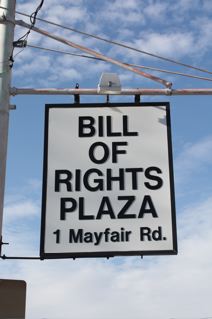
With Monday being Bill of Rights Day, it gives me a chance to write about a shopping plaza. Yeah, I know, that isn’t really the first thing to jump to your mind when discussing our rights. But as you can see from my photo, this particular shopping strip is called Bill of Rights Plaza, and it’s a couple miles from my home.
As it happens, Westchester County, just north of NYC for you out-of-towners, played a pretty big part in the creation of freedom of the press. It started with an election in 1733 on the village green in front of St. Paul’s Church in Eastchester. It seems that some folks wanted to vote, and others tried to stop them. Yes, I know that some things haven’t changed.
John Peter Zenger wrote about those voting irregularities, and in doing so was critical of the colonial governor. But since criticizing the British crown or its colonial puppets was not something to be tolerated, he was promptly arrested and put on trial for seditious libel. The truth of his writings was irrelevant under the law of seditious libel. To help insure a guilty verdict, the governor picked the judges.
Zenger’s defense — and the reason I write about it 275 years later — was novel; instead of contesting whether he he was guilty of the crime, he contested the law itself. Since what he wrote was true, he argued, he couldn’t be guilty of libel. The jury was asked to disregard the law, a concept we now call jury nullification. And the jury found Zenger not guilty.
From this one trial was born a concept that every member of the press (and every blogger, whether you think you are press or not) cherishes, for it now forms part of the First Amendment:
Congress shall make no law respecting an establishment of religion, or prohibiting the free exercise thereof; or abridging the freedom of speech, or of the press; or the right of the people peaceably to assemble, and to petition the Government for a redress of grievances.
Whether our nation’s founders thought it would be a good idea to name a shopping plaza after the Bill of Rights is another story. But if it makes a child or two ask their parents about that sign, then it seems to be worth it.
Updated:
Marc Randazza at the Legal Satyricon has put up a sensational Blawg Review #190, dedicated to the Bill of Rights. He’s got commentary from around the legal blogosphere on all ten.
See also:
- The Right to Defend (Greenfield @ Simple Justice, 4/23/08)
- The Rare Ruby-Throated Jury Nullification (Reed @ Deliberations, 2/26/07)
Links to this post:
it’s bill of rights day
as blawg review’s righteous editor reminded us a few days ago, president bush has declared today to be bill of rights day. you’ll find the text of the bill of rights — the first ten amendments to the us constitution — at the foot of …posted by David Giacalone @ December 15, 2008 12:57 PM
blawg review #190 – bill of rights day
billofrightsplaza-779503 the carnival of law bloggers has honored us with the privilege of hosting blawg review #190. we decided that since it was a carnival, we would just hold a freak show — no links to other blawgs, just pictures of …posted by marcorandazza @ December 15, 2008 7:29 AM

